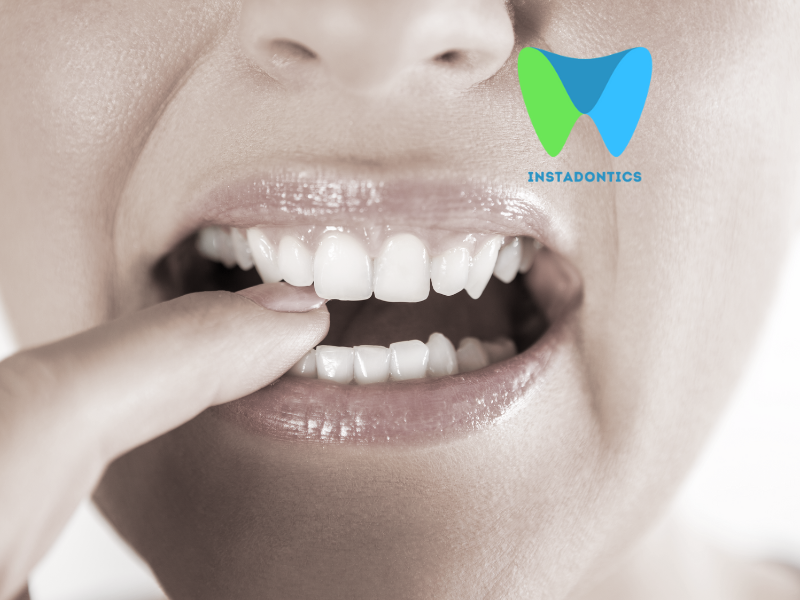What Causes Tooth Pain When Eating Sweets? Have you ever taken a bite of your favorite dessert—maybe a piece of chocolate cake or a sugary candy—only to be hit with a sudden, sharp pain in your teeth? It’s more common than you think. If you’re wondering, “Why do my teeth hurt when I eat sweets?”—you’re not alone. Sugar-related tooth sensitivity affects millions of people and often signals underlying dental issues that shouldn’t be ignored.
In this post, we’ll walk you through the common reasons why your teeth may hurt when eating sugary foods, how to identify the warning signs, and most importantly, what you can do about it.
What Causes Tooth Pain When Eating Sweets?
Several dental issues can make your teeth sensitive to sugar. Let’s explore the most common ones:
1. Tooth Sensitivity (Dentin Hypersensitivity)
Tooth sensitivity happens when the protective outer layer of your teeth (enamel) wears down, exposing the softer inner layer called dentin. Dentin contains microscopic tubules that lead to the tooth’s nerve center (pulp). When sugar enters these exposed areas, it can stimulate the nerves and cause pain.
Common triggers:
- Cold drinks
- Sweet foods
- Brushing too hard
- Acidic foods
Statistic: According to the Journal of the American Dental Association (JADA), nearly 1 in 8 people suffers from dentin hypersensitivity.
2. Cavities (Dental Caries)
Cavities are small holes in your teeth caused by acid-producing bacteria that thrive on sugar. These acids demineralize your enamel and expose the sensitive layers beneath.
If you have early-stage tooth decay, sweet foods may aggravate the area, leading to sharp, localized pain. Left untreated, cavities can grow deeper and affect the tooth pulp, resulting in more severe and constant pain.
Warning signs of a cavity:
- Pain when eating sugar or cold foods
- Visible holes or dark spots
- Persistent bad breath
3. Enamel Erosion
Your enamel is the hardest substance in the human body—but it’s not invincible. Acidic beverages (like sodas), aggressive brushing, or reflux can gradually erode enamel, leaving teeth vulnerable.
When enamel wears away:
- The dentin becomes exposed.
- Sugars penetrate more deeply and irritate the nerves.
- Pain may occur during or after eating sweet items.
Tip: Enamel doesn’t grow back—protect it while you can.
4. Gum Recession and Root Exposure
Gums can recede due to periodontal (gum) disease, aggressive brushing, or age. As gums pull away from the teeth, they expose the root surfaces, which lack enamel.
Since roots are much more sensitive to external stimuli like sugar and temperature changes, eating sweets can become painful.
5. Recent Dental Procedures
If you’ve recently had a filling, whitening, or other dental work, it’s normal to experience temporary sensitivity and Pain after eating Sweets. However, if sugar continues to cause pain weeks after treatment, let your dentist know—it may indicate complications like nerve irritation or incorrect bite alignment.
How to Tell What’s Causing Your Sweet Tooth Sensitivity
Here’s a quick checklist to help you pinpoint the cause:
| Symptom | Possible Cause |
|---|---|
| Pain with cold AND sweets | Tooth sensitivity |
| Localized pain in one spot | Cavity or cracked tooth |
| Pain near the gumline | Gum recession or root exposure |
| Ongoing pain after sweets | Advanced decay or infected pulp |
| Pain after dental work | Temporary sensitivity or nerve irritation |
What Does “Lingering’ Pain After Eating Sweets Actually Mean?
Lingering pain refers to tooth discomfort that lasts longer than a few seconds after the sweet food or drink is gone. It’s not just a quick twinge — it’s a pain that stays with you, often for 30 seconds to several minutes, sometimes even longer. This type of pain typically signals that the tooth is inflamed or damaged below the surface.
Here’s what lingering pain is not:
- A brief, sharp sensitivity to cold or sugar that disappears right away.
- Discomfort from chewing something hard that fades quickly.
Instead, lingering pain usually points to a deeper problem, such as:
- Tooth decay that has reached the dentin or pulp (the inner nerve).
- Pulpitis, or inflammation of the dental pulp — often caused by untreated cavities.
- A crack or fracture in the tooth that exposes sensitive tissue.
- A leaky filling or crown where bacteria or sugar can seep inside.
The key factor with lingering pain is duration and intensity. If the pain continues well after the sugary food is gone, that means the nerves inside the tooth may be overstimulated or inflamed — and sugar exposure is triggering an exaggerated response.
In dental terms, this often suggests reversible or irreversible pulpitis:
- Reversible pulpitis: The pain lingers but eventually fades. The pulp is irritated but not permanently damaged.
- Irreversible pulpitis: Pain lingers for minutes or longer, may throb, and can be spontaneous. The nerve may be dying and may require a root canal.
When Should You Worry About Pain After Eating Sweets?
If the pain after sweets:
- Lasts longer than 10–15 seconds
- Comes back consistently in the same tooth
- Is accompanied by throbbing or pressure
- Wakes you up at night or worsens with hot drinks
…then it’s likely more than just sensitivity — it could be a sign of decay or pulp damage, and you should see a dentist promptly.
How to Treat Tooth Sensitivity from Sugar
Treating tooth sensitivity to sweets depends on identifying the underlying cause—whether it’s enamel loss, decay, gum issues, or general nerve sensitivity. Below are effective and commonly recommended treatments, explained in greater depth:
1. Desensitizing Toothpaste
One of the simplest yet effective first steps is switching to a toothpaste designed for sensitive teeth.
- How it works: These toothpastes typically contain potassium nitrate, which calms the nerves inside the teeth, or stannous fluoride, which creates a protective barrier over exposed dentin.
- Brands to consider: Sensodyne, Colgate Sensitive Pro-Relief, Crest Gum & Sensitivity
- How to use it effectively:
- Use it consistently—twice a day is ideal.
- Avoid rinsing immediately after brushing to let the active ingredients work longer.
- Apply a small amount directly to the sensitive spot with your finger if needed for spot treatment.
Tip: It can take up to two weeks to notice a significant reduction in sensitivity, so don’t give up too soon.
2. Fluoride Treatments
Fluoride isn’t just for kids—it plays a major role in adult oral health, too. | What is dental fluoride treatment?
- In-office treatments: Dentists may apply a concentrated fluoride varnish, gel, or foam to your teeth to help remineralize weakened enamel and seal exposed dentin.
- At-home options: Prescription-strength fluoride toothpaste or mouth rinses may also be recommended.
Benefits:
- Strengthens enamel
- Helps reverse early-stage demineralization
- Reduces sensitivity caused by enamel thinning
When it’s most effective: Ideal for patients with early enamel erosion or generalized sensitivity not linked to a specific cavity.
3. Fillings or Sealants
If your sensitivity stems from cavities or micro-cracks in your teeth, restorative dental work will be necessary.
- Fillings: For minor to moderate cavities, your dentist will clean out the decayed tissue and fill the area with composite resin or another dental material. This prevents sugars and acids from reaching the nerve.
- Sealants: Often used on back teeth to block food and bacteria from collecting in grooves. While commonly applied to children’s teeth, they’re increasingly used for adults with deep pits or mild sensitivity.
What to expect: Fillings can provide immediate relief once the decay is removed. Sealants are painless and typically applied without anesthesia.
4. Gum Treatment
If your gums have receded or you have early signs of periodontal disease, the roots of your teeth may be exposed—and root surfaces are far more sensitive than enamel-covered areas. This causes Pain After Eating Sweets.
Treatment options include:
- Scaling and root planing (deep cleaning): This procedure removes plaque and bacteria from beneath the gum line and smooths the root surfaces to encourage reattachment of the gum tissue.
- Gum graft surgery: In more severe cases, a small amount of healthy gum tissue (from your palate or a donor source) is grafted onto the receded area to protect the exposed roots.
Results: Patients often experience a noticeable reduction in sensitivity after the tissue heals.
Note: Left untreated, gum recession can lead to bone loss and even tooth loss—so prompt intervention is key.
5. Avoid Acidic and Sugary Foods
While treatment addresses the cause, your daily habits play a huge role in preventing recurring sensitivity.
Foods and drinks to limit or avoid:
- Sodas and carbonated drinks (including sugar-free ones)
- Citrus fruits and juices
- Candy, sticky sweets, and high-sugar snacks
- Sports and energy drinks
What to do instead:
- Choose sugar-free gum with xylitol to stimulate saliva and neutralize acids.
- Drink water or milk instead of acidic or sugary beverages.
- Rinse your mouth with water after eating acidic or sweet foods, especially if you can’t brush immediately.
- Don’t brush immediately after acidic foods—wait at least 30 minutes to avoid scrubbing away softened enamel.
Bonus Tip: Using a straw can reduce the amount of contact acidic drinks have with your teeth.
6. Nightguards and Bite Correction
Sometimes, tooth sensitivity is worsened by bruxism (teeth grinding) or malocclusion (bite misalignment).
- Custom nightguards protect teeth from the wear and tear caused by grinding.
- Orthodontic evaluation may be necessary if bite misalignment contributes to uneven pressure or enamel wear.
Why it matters: Even if sugar seems to be the trigger, underlying mechanical wear can amplify pain and increase your vulnerability to sensitivity.
Preventing Future Tooth Pain from Sugar
An ounce of prevention is worth a pound of cure. Follow these practices to protect your teeth:
- Brush twice daily with a soft-bristled toothbrush
- Use fluoride toothpaste to strengthen enamel
- Avoid acidic drinks like soda and citrus juices
- Visit your dentist every 6 months for check-ups
- Use a straw when drinking acidic beverages to limit contact with teeth
- Wear a nightguard if you grind your teeth
When to See a Dentist
If you’re frequently asking yourself, “Why do my teeth hurt when I eat sweets?”, it’s time to get professional help.
Make a dental appointment if you experience:
- Persistent tooth pain
- Pain that worsens over time
- Swelling or bleeding gums
- Sensitivity in one specific tooth
Early diagnosis can prevent minor issues from becoming major problems.
Don’t Ignore Sugar Sensitivity
Sweet tooth pain isn’t just annoying—it’s a sign that your oral health may need attention. Whether it’s enamel erosion, cavities, or exposed roots, getting to the root of the problem can save you discomfort, money, and time in the dentist’s chair.
Take action today: Book an appointment with your dentist, switch to sensitivity toothpaste, and be mindful of sugar intake. Your smile—and your nerves—will thank you.
FAQs
1. Is tooth sensitivity to sugar always a sign of cavities?
No. It could also be due to enamel erosion, gum recession, or general tooth sensitivity.
2. Can sensitivity toothpaste really help?
Yes. Many over-the-counter toothpastes contain ingredients that block nerve signals and help reduce pain over time.
3. Are sweets more harmful than other foods?
Sweets feed harmful bacteria in your mouth, which produce acid that can lead to cavities and sensitivity. Moderation and good hygiene are key.
4. Will the pain go away on its own?
Occasional sensitivity might resolve with better oral care, but persistent pain requires a dental evaluation.
5. What’s the fastest way to stop tooth pain after sugar?
Rinse your mouth with warm water, avoid the sugary item, and use sensitivity toothpaste until you can see your dentist.



